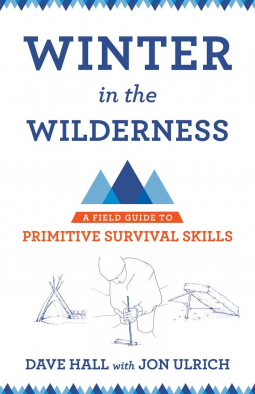
Winter in the Wilderness
A Field Guide to Primitive Survival Skills
by Dave Hall
This title was previously available on NetGalley and is now archived.
Send NetGalley books directly to your Kindle or Kindle app
1
To read on a Kindle or Kindle app, please add kindle@netgalley.com as an approved email address to receive files in your Amazon account. Click here for step-by-step instructions.
2
Also find your Kindle email address within your Amazon account, and enter it here.
Pub Date Nov 18 2015 | Archive Date Sep 15 2015
Cornell University Press | Comstock Publishing Associates
Description
Camping or backpacking in winter is appealing for many who enjoy the serenity of wilderness settings without the crowds and bustle of the summer season. But as rewarding as they can be, these outings require special preparation and a different set of skills than are necessary at other times of the year. Snowfall can quickly cover one's tracks and make orientation difficult. Hypothermia is insidious, and rapidly changing weather conditions can become treacherous, even life-threatening.In addition to those who are exploring the outdoors recreationally, there are also those who find themselves in unexpected winter survival situations. Each year, people become stranded in wilderness areas, and in most cases they are not equipped to face the challenge of spending an indefinite amount of time outside. Without sufficient gear or knowledge of how to improvise without it, injury or death is often the result. The development of some basic skills, however, can help avert such unfortunate outcomes.As the founder of the renowned nature awareness program Primitive Pursuits, Dave Hall has been practicing survival skills for more than twenty years and has amassed a comprehensive understanding of winter survival. By refining these skills, Dave has reached a point of understanding that is without peer. Through detailed explanations, illustrations, and personal anecdotes, Winter in the Wilderness imparts Dave's knowledge to readers, who will learn to meet their most basic needs: making fire, creating shelter, obtaining safe drinking water, navigating terrain, and procuring sustenance.Winter in the Wilderness is a handbook for those who want to explore cold-weather camping and those who might find themselves in need of this critical information during an unexpected winter's night out. Whether used for pleasure or for survival, Winter in the Wilderness emphasizes the benefits of enriching and deepening our connection with the outdoors.
Available Editions
| EDITION | Other Format |
| ISBN | 9780801479953 |
| PRICE | $16.95 (USD) |
Links
Average rating from 6 members
Featured Reviews
 Mike M, Media/Journalist
Mike M, Media/Journalist
A must-read for anyone who is serious about survival in any setting.
Before sharing my thoughts of this book, I'll share my background and experience to illustrate my expertise, igorance, and bias.
Background on the reviewer
I've spent many weeks backpacking in the winter or in winter-like conditions. For example, when I did a round-trip on the Continental Divide Trail, I walked across Colorado in May. When you're in the Rocky Mountains in May, it sure looks and feels like winter, even though officially it's spring. The mountains are buried in snow and freezing temperatures are the norm.
My most memorable winter trip was when Lisa Garrett and I did a 4-day backpacking trip in Yosemite during Thanksgiving (late November). You can see some photos from that snowy experience.
I've also climbed many snowy peaks, such as nearly all the peaks in Cascade Mountain Range (e.g., Mt. Rainier, Mt. Hood, Mt. Baker, Mt. Adams, etc...), as well as snowy mountains outside the USA, such as Mont Blanc.
Despite all these situations, I have only once been in a true winter survival situation. That was in late March 2006 when Maiu and I got lost in the Olympic National Park. I've wanted to write about that life-threatening experience for a while years, but until I do, let's just say that we almost died. We spent two nights (one of which snowed on us) in a diabolical ravine. We both ended up with frostbite, but we got out on our own.
Another time I was snowshoeing in Idaho for the day with Julia, my Ukrainian girlfriend at the time. We got lost as the sunset and kept walking until we ran into man running a snowplow at 3:00 a.m. We were walking the wrong way and he took us to
Therefore, it was great interest that I read Winter in the Wilderness. Here are the pros, cons, and verdict of the book.
What the Winter in the Wilderness covers
Winter in the Wilderness is a 216-page book that is broken up into seven sections and four useful appendices. The seven sections are:
Priorities Fire Shelter Water Sustenance Helpful Crafts and Skills Navigation and Orienterring The four appendicies are:
Motor Vehicle Considerations (where you're told what to do if you're stuck in your car in a remote place in the winter)
Survival Kits Winter Gear Checklist Suggested Reading Strengths of Winter in the Wilderness
The appendix, especially the survival kits and winter gear checklist are extremely useful. Many illustrations, which are useful to visualize how to make a snow cave or how to set a snare. It gives you all the basic and intermediate things you need to know to survive in the wilderness.
Weaknesses
The cover stinks. Yes, I'm being superficial, but the cover looks like a self-published nightmare, not something done by Cornell University.
Although the illustrations are useful, they are the same quality as Tom Brown's classic book, Field Guide to Wilderness Survival. Brown's book was written before the era of desktop computing and computer graphic illustration. I would have preferred surperior graphics and/or photos. Usually I could see what they're trying to show me, but sometimes a better graphic would have helped.
His experience is mostly in New York state. Although talks about situations where you might not find abundant trees or animals, the information is minimal.
It's not super comprehensive. At 216 pages, you can't expect it to cover all the possible edible plants in the world, for example. Who should buy Winter in the Wilderness?
Novices and intermediate backpackers.
Anyone who fears freezing to death in the woods.
Most mountaineers - because you never know when you'll blow off the mountain.
Preppers who want to survive the nuclear winter.
Who should NOT buy Winter in the Wilderness?
Advanced backpackers who have spent significant time in the woods probably won't learn much in this 216-page book.
Verdict
Most survival guides tell you to stay put when you're in trouble. Conventional wisdom says that the biggest mistake people make is trying to walk out.
However, I've always walked out because I sensed that safety wasn't that far away. Indeed, in the USA, it's hard to be more than 50 km (35 miles) from a road. And I always felt strong enough to just keep walking. Had I stayed, I would have to depend on someone saving my ass. Finding someone in the wilderness is hard, especially if you're off-trail, which is often where you are when you're lost. I'd rather not be stuck there for days or weeks. Staying put and making a shelter isn't always the best solution.
Still, this book does an excellent job at teaching how to survive for days, even in the frigid wilderness.
I'm giving Winter in the Wilderness 4 out of 5 stars.
 Sue B, Reviewer
Sue B, Reviewer
Quote from Winter in the Wilderness
"...the driving force behind primitive survival is that all of our needs can be met through a deep and meaningful relationship with the earth…without the aid of gear or technology.
The purpose of this book is to go beyond the fundamentals of winter survival and introduce readers to this relationship."
.
If you walk or drive into any wilderness to play… you need this book!
Winter has always been my favorite season for outdoor activities. Somehow I managed to survive my early years in the brutal Adirondack winters despite some pretty stupid mistakes in judgment.
As a child, no guidebook could have helped me prepare for winter's first cruel lesson. Don't lick snow off a metal porch railing or stick your tongue on a flagpole in the school yard. I think the urge to lick a frozen metal object must be related to every child's urge to stick beans up their nose. Thankfully I outgrew my need to peel skin off my tongue and found healthier winter sports.
My year-round Adirondack Mountains playground tested my strength and ability to adapt to brutal winter conditions. Somehow I survived a cross country ski trip through Avalanche Pass to the Flowed Lands wearing wet blue jeans or my climb over the Dix Mountains in a freezing drizzle after forgetting my rain gear. Thank God for a plastic bag pack liner!
The last 25+ years I have lived in Georgia where I spend time backpacking the wilderness trails in the Georgia, North Carolina, Tennessee and southern Virginia mountains.
My husband and I hiked out of Georgia in the dead of winter to thru-hike the Appalachian Trail. Our northward progress ended after 1800+ miles when I was injured on Mt. Washington, NH.
My years of cold weather observations have left me amazed at the poor choices people make when facing winter conditions. Before and after we returned from our AT adventure, my husband and I shuttled hikers to the remote southern terminus of the Appalachian Trail. It is not uncommon to find people heading out on a six-month odyssey without rain gear, without any type of portable shelter, inadequate winter clothing and no method of heating water or cooking a hot meal. We have been called to rescue hypothermic hikers caught in unexpected wet weather. We have shared food with hikers stranded by a winter storm. We've built fires in the rain to help soaked hikers in near freezing temperatures warm themselves.
Why, you might ask, would Georgians find a winter survival guide interesting? Most people don't associate snow storms with Georgia. Granted, our winter storms aren't as frequent or severe as my native New York State but they do happen and they shut the state down. Just as dangerous, if not more so, are the freezing rain and ice storms. Fat chance for a quick rescue if the eroded and remote Forest Service Road you drove to the trailhead becomes iced over or clogged with downed trees.
A guidebook to surviving an unexpected winter emergency in any of the wilderness areas of Georgia is just as important as one aimed at keeping you alive in the Adirondacks.
. The summary of Winter in the Wilderness: A Field Guide to Primitive Survival Skills by Dave Hall with Jon Ulrich led me to request a pre-publication copy from Netgalley and Cornell University Press. I am very grateful that I was approved.
Dave Hall is resident of the Adirondacks and has spent years learning primitive outdoor skills, enjoying many a bitter night in a snow cave without benefit of a sleep bag or warming fire. He has studied with other nationally known survival experts and is a popular instructor for the Adirondack Mountain Club and the Cornell Outdoor Education program. He shares his well honed skills with the youth of his community through Primitive Pursuits, an afterschool program he began in 1999. His 20+ years of mastering primitive survival skills have led him to become a known authority.
I highly recommend reading the introduction before jumping ahead to any of the seven chapters. He tells us that developing primitive survival skills is more than knowing what to do in an emergency; it is doing it competently in an emergency. The specific skill needed in any particular situation must have been practiced in advance that it becomes second nature. Mastering the skills can be enjoyable in a controlled setting.
The book is written in an easy conversational style. Dave reveals his own failings in the past that led him to improve those weaknesses in his survival skill set. I felt like I was sitting down at campfire, listening to someone comfortable in his own skin and willing to share his knowledge without shoveling it down my throat.
If you are a gear freak and devoted to the newest fabrics and lightest weight equipment, you will be disappointed. If you are thinking about what you need for winter hiking and what dangers can befall you, here you go. The gear lists and recommendations in the book are meant to provide guidance. Readers planning to head out to recreate or travel must prepare in advance. What if?
When I grew up in the dark ages, cell phones and GPS devices weren't available. I have found, in the past few years, having those devices has created a false sense of security. There is a danger in relying on them as the only source of directions or help. The author acknowledges that they have their place but should not be seen as a sure method of securing help.
Chapter 1 discusses Priorities In my mind, this is the most important section. He covers basic needs and dangers; avoid panic, hypothermia and frostbite, clothing and attire, worst case scenarios as examples. If you can't see yourself taking this chapter seriously, you need to stay home, don't endanger the lives of your rescuers and enjoy the wilderness from your lounge chair watching the Discovery Channel.
Chapters 2- 7 cover individual skills in deeper detail. There are plenty of hand drawn graphics. They are Fire, Shelter, Water, Sustenance, Helpful Crafts and Skills, Navigation and Orienteering.
Additionally there are four handy appendices.
Appendix A: What to do if you are stranded in your vehicle. Very useful suggestions!
Appendix B: Survival Kits
Appendix C: Winter Gear Checklist. Many will scoff at the list and consider it overkill. If you haven't been in a 30-below zero storm overnight don't mock it! Better to have than have not. You can modify it with experience and weather conditions.
Quote from Clarence Day.
"Information is pretty thin stuff until mixed with experience"
Appendix D: Suggested Reading. There is also a bibliography and a handy index.
There are a couple of suggestions and comments I would make to improve the next edition of this book.
• The hand drawn graphics are well done, but I personally would like to see color photographs with close-ups. Jazz it up and make it inviting to practice.
• A photograph on the cover.
• More discussion on survival techniques in areas where trees and kindling are not available.
• My what-ifs include winter in warmer climates.
My overall rating is thumbs-up. Recommend for families interested in primitive camping and individuals willing to challenge themselves and expand their seasonal activities. I have placed my order for the paperback copy!
As mentioned before, thanks you, Netgalley and Cornell University Press for the ARC in exchange for an honest review.
Readers who liked this book also liked:
Scott Michael LeRette
Biographies & Memoirs, Christian, Parenting, Families, Relationships
Jeff Fulmer
General Fiction (Adult), Politics & Current Affairs, Religion & Spirituality


















